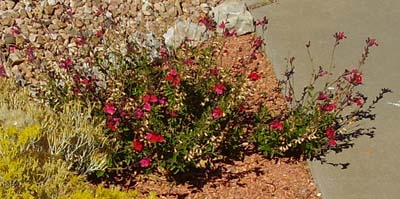RICHARD S. DARGAN | Landscape
Autumn Sage | |||||||
   |
Species: Salvia greggii A modest-sized perennial shrub with bright, tubular-shaped flowers, Autumn sage enlivens many otherwise barren patches of earth in the American Southwest. The commonly seen Furman's red variety is an effective backdrop for low-growing annuals like pansies, or as a color contrast to common drought tolerant plants like the chamisa (bottom left), Russian sage and yarrow. Autumn sage is not a demanding plant—once established, it requires only a little attention. It likes well drained soil and does well on banks and slopes. Pruning it back by one-third in the early spring and pinching off the old flowers during the summer will encourage more blooms. Autumn sage is one of the more than 900 species of Salvia, the largest genus of the mint family. The species was named Salvia greggii (pronounced greg-EYE) in honor of Josiah Gregg (1806-1850), an explorer whose two-volume book, Commerce of the Prairies (1844), described the natural world of New Mexico and Texas. During an 1848 expedition to western Mexico and California, Gregg sent several specimens to St. Louis botanist George Engelman, including the Autumn sage. Subsequently, the American Botanical Society added the Latin name “greggii” in his honor to 23 species of plants.
|
||||||